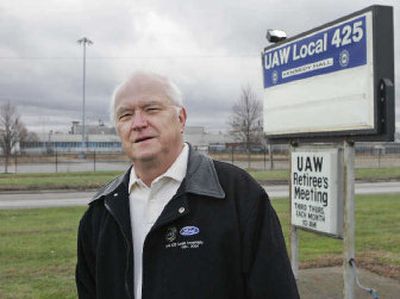The cities Ford left behind

LORAIN, Ohio — He glances through the chain-link fence at hulking, dark buildings and weeds growing tall in pavement cracks. The chilling scene on a gray November day makes John “Larry” Wargo sigh with sadness.
He remembers when the parking lots were packed — with workers’ cars and freshly assembled vehicles waiting to be sent from the Lorain Ford Assembly Plant to market.
“We were working double shifts and making 58 cars an hour, Thunderbirds and Cougars,” says Wargo, 70, a retired Ford Motor Co. worker who put in 40 years, mostly as a maintenance electrician. “I feel sorry for the younger generation, because they won’t see what really happened there.”
It’s been nearly a year since this Lake Erie port city of 68,000 began wrestling with its reality of a future without Ford. It’s a future other American cities face now that the company plans to close 16 plants by 2012, some in places already hit hard by the loss of steel and other factory jobs.
Ford has idled or plans to idle nine plants so far. It can’t close any of them until September because of its agreement with the United Auto Workers union.
Lorain, which worked out an agreement with Ford to close its plant early, is trying to find a buyer for the site as it fights to make ends meet. The income tax has gone up and city jobs have been cut. Potholes take longer to fill and grass isn’t cut as often.
In Edison Township, N.J., a suburb of New Brunswick, where a Ford truck assembly plant closed in 2004, Hartz Mountain Industries is converting the site into stores, a small hotel, a community center and theater, said Gloria Dittman, president of the chamber of commerce.
But many cities say they can’t begin such planning until the closings are official.
“If we as a city get involved, that could create an awkward situation. We can’t really do anything with somebody else’s property,” said T.R. Carr, mayor of Hazelwood, Mo., where Ford in March idled a plant that employed 1,445.
The approaching closings come as automakers, hurting from expensive health care, cheaper foreign competition and other problems, look to cut costs.
Almost half of Ford’s hourly production workers — 38,000 so far this year — have accepted buyouts or early retirement offers from the nation’s second-biggest automaker, which lost $7 billion in the first nine months of the year.
About a year ago, General Motors Corp. made public a plan to idle 12 plants over three years. GM spokesman Dan Flores said so far production has stopped at assembly plants in Oklahoma City and Lansing, Mich., and at a sheet metal stamping plant in Lansing.
For all these cities, “it’s all a question of getting property back into a tax base,” said Kelly Novak, a research manager for the Washington-based National Association of Development Organizations.
Many of the cities awaiting Ford closings mirror Lorain, a blue-collar town where the plant had been part of the industrial identity since 1958. Jobs there peaked at about 7,500 in the early 1970s. Ford stopped making Cougars and Thunderbirds there in 1997. During 2005, the work force dropped from about 1,700 to 750. Days before Christmas last year, Ford produced its last Econoline in Lorain.
Lorain jobs and workers, as well as Econoline van assembly, went to a Ford plant in nearby Avon Lake. The workers tend to live in the northeast Ohio region, not just the city, so there wasn’t much population shift.
Loss of the plant meant $2.2 million less income tax revenue for a city that was already struggling with the loss of some 12,000 steel jobs in the past few decades. Lorain passed an emergency five-year, quarter-percent income tax increase to generate $2.4 million a year — about $62 a year more on a $25,000 income — but, said Mayor Craig Foltin, the city still cut about 100 jobs, including in the streets and parks departments.
One trucking company that depended on Ford went out of business, and electrical, carpentry and plumbing independent contractors feel the pinch, Foltin said.
Mary Beth Deily, an associate professor of economics at Lehigh University in Pennsylvania, said not every industrial city feels the same pain when plants close.
“A lot depends on the size of the city a plant is in. A plant site in a smaller city, like the one in Lorain, presents more of a challenge than if a plant is closed in a big city, which can better absorb the impact,” she said.
In Hapeville, Ga., an Atlanta suburb, the impending closing of a Ford assembly plant could bring good change in an age where industrial sites in residential areas no longer mix, said Robin Howarth, the city’s director of economic development.
“Atlanta is growing rapidly, so we are developing more of a live-work-play community,” he said. “We’re confident we can bring in mixed-use retail, a biotech industry or something like that.”